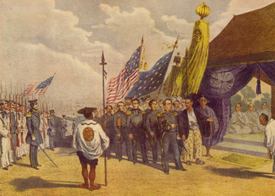Image may be NSFW.
Clik here to view. It is a term still used in Japan today. “Black Ships” refers to any threat to Japanese culture from Western technology. Yet without the original “black ships” of 1853, we would not enjoy our Hondas, Nintendos or Sonys. It took a pudgy naval officer to bring Japan into the modern world–kicking and screaming.
It is a term still used in Japan today. “Black Ships” refers to any threat to Japanese culture from Western technology. Yet without the original “black ships” of 1853, we would not enjoy our Hondas, Nintendos or Sonys. It took a pudgy naval officer to bring Japan into the modern world–kicking and screaming.
To understand the reluctance, you must understand Japan. This was a place that literally was “closed for renovations” for centuries. For approximately 250 years, the Tokugawa shogunate, the dynasty of military rulers that held de facto rule on the islands, decided to sever almost all ties with the outside world. After centuries of internal strife and outside interference by missionaries, traders and Chinese invasions, Japan decided to close up shop so it can get its act together.
It allowed one port, Nagasaki, and one Western country, the Netherlands, to trade with Japan. This suited the Japanese well: the Dutch wanted no part of colonizing Japan, Japan had no need for the Dutch spreading Calvinism and personal freedoms to the island. Although other influences were able to sneak in here and there, particularly in relations with China, Japan would be in relative isolation for the next two and a half centuries.
Yet sometimes the renovations take too long. It was time for Japan to open up shop.
The Dutch knew it, as they sent a letter in 1844 to the Japanese asking to open up trade. The Americans knew it, too, as they sent unsuccessful missions to Japan in 1837, 1846 and 1849. There was also technology to consider: a lot has changed in 250 years, especially in warfare. The Japanese army and navy was woefully underdeveloped to withstand any conflict with a Western power, let alone an all-out war.
So on July 8, 1853, Commodore Matthew C. Perry (No relation to the Friends actor, by the way) sailed into the Uraga harbor near Edo, now Tokyo to present a letter by President Millard Fillmore issuing terms for a treaty. The Japanese government told him to head to Nagasaki, as that’s where the trading post is. Perry was having none of it, insisting on delivering his message and returning for a reply.
The Japanese have fended off these attempts before. Yet the business end of an 18-pounder, multiplied by several hundred, makes anybody whistle a different tune–especially if your capital city is made of mostly wooden buildings. Since these fearsome warships were pitched with tar to keep them watertight, they were referred to as the “Black ships”. The Japanese had no choice but to receive his message and consider a response.
Perry returned in February of 1854. He heard that the Japanese treaty would satisfy all American demands, but Perry was sure to hedge his bets. So he brought twice as many frigates as before, to make sure the Japanese keep their end of the deal. On March 31, 1854, the Convention of Kanagawa was signed, allowing US ships to trade in Japanese ports and the establishment of US diplomatic relations with the Japanese government. Perry came home a hero in 1855, only to drink himself to death in 1858.
Although the approach was a bit heavy-handed, Perry’s expedition became a watershed in world history. Japan, long isolated from the world, now had access to Western ideas, technology and military might. It would cause major internal conflicts, culminating in the removal of the shogunate in 1867 and the establishment of a semi-constitutional monarchy. In Japan’s hunger for new things, however, they managed to step on a lot of toes–let’s not forget World War II. Yet in the modern age, Japan has become a technological, financial and industrial power in full openness with the international system.
The fear of the “black ships” always remains, however. Japan is a society that struggles to maintain its own distinct culture in the overwhelming onslaught of technological innovation–mostly its own doing. It is a struggle many societies face in the 21st Century, as streams of communication reduce or obliterate the barriers that made Japanese isolation such an enduring institution.
Come September, the fear of “black ships” and the cross-connections of cultures is definitely a theme to build on with your students. How do we reconcile our own cultural identity with the modern world?
Or, at the very least, stress that those Sony Playstations and Nintendo DS systems didn’t just spring from the Earth by themselves.
Posted in Uncategorized Tagged: "Black Ships", American History, code-switching, Comedy, Commentary, Communications, Cultural Literacy, Education, History, Humor, Humour, Japan, Japanese History, Matthew Perry, Opinion, Social studies, Tokugawa Shogunate, U.S. History, World War II Image may be NSFW.
Clik here to view.
 Image may be NSFW.
Image may be NSFW.Clik here to view.